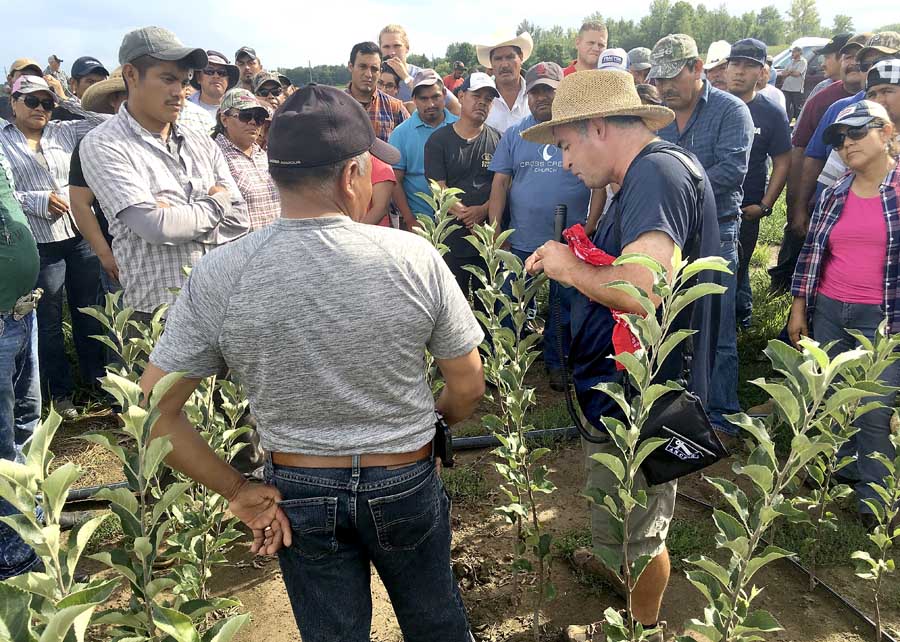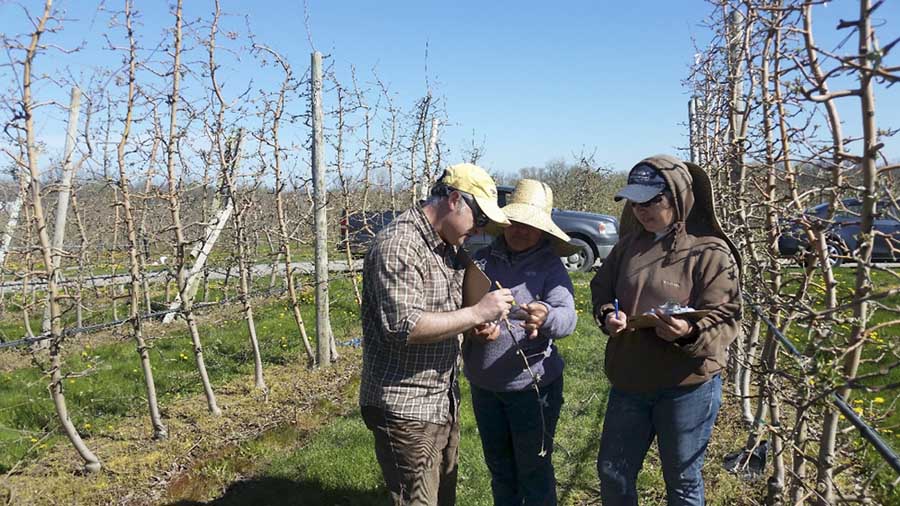
Participants who attended the 2016 Hispanic Summer Fruit Tour heard a presentation from Mario Miranda Sazo (right), Cornell Cooperative Extension fruit specialist, and Juan Pascal (left), a VanDeWalle Fruit Farm employee with 30 years of nursery experience, on feathering and tree growing techniques near Alton, New York. (Courtesy Matt Wells/Cornell Cooperative Extension)
Even as growers plant high-density orchards that require significant labor to maintain, many still lack a reliable, skilled and committed horticultural team to fuel the growth they could see in the next decade.
It’s a competitive challenge. Finding, attracting and retaining the right people is key to growing and remaining a player in an increasingly global marketplace.
Assembling a team of people who will support development of new business opportunities may not be easy, but assembling the wrong people can be costly and catastrophic.
Innovative fruit companies understand that it is much cheaper to develop a highly skilled and motivated team than it is to go out and bring in new people year after year.
Empowered employees and orchard managers will perform at their best level, make independent decisions and find ways to improve orchard operations, including planting, pruning, hand thinning and harvest.
Building a team
Creating a high-functioning horticultural team is challenging under any circumstances, but when the team you are trying to build crosses different cultures, you must meld talents and cultural expectations while alleviating communication barriers.
Complicating your communication is the probability that you will incorporate the use of some type of new technology and won’t be fully able to explain the benefits of the technology to your Spanish-speaking employees.
In this complicated and rapidly evolving labor situation for fruit growing, you have to take action to capitalize on new opportunities and execute them efficiently.
But it is also essential for you and your teams to learn quickly, to keep up with developing events and to stay ahead of the competition.
That will happen only if you foster strong working relationships with your most talented Spanish-speaking employees and assemble skilled horticultural teams inside your farm.

Mario Miranda Sazo explains to Hispanic employees how to differentiate floral and vegetative buds. (Courtesy Mario Miranda Sazo)
While there is no single secret to success when building the perfect horticultural team, there is one common trait I recognize in the most successful fruit growers who employ Spanish-speaking employees at their operations: communication.
One of the single greatest changes you can make is to build basic Spanish-speaking relations in the orchard.
No matter how good or how poor your Spanish pronunciation is, you must learn to say “Buenos dias” (Good morning), “Como está hoy?” (How are you doing today?). You can also say a few words in Spanish and smile – and mean it! When you or I smile sincerely, the warmth becomes self-reinforcing.
When I am asked to serve as a translator for a meeting between a grower and the Spanish-speaking orchard workers, frequently the first question that the employees will ask their “patrón” (boss, in Spanish) is, “How am I doing in my job?” Though the grower may have just finished going through a list of things that have been done well and some that need improvement, Spanish-speaking employees crave one-on-one contact, horticultural coaching and constructive feedback — positive or negative — from their boss or orchard manager.
Some growers do a good job of addressing this question, if not on a daily basis, then at least when they have a translator available.
You, the grower, must show real interest in the well-being of your orchard workers and regularly ask some of the questions mentioned above.
This sort of attention to Spanish-speaking communication creates a relationship between you and your orchard worker, with the result that the labor task receives maximum attention.
Your workers’ commitment to the fruit farm is also increased. If you work hard at this aspect of communication with your Spanish-speaking employees, you will create better, trusted, longer-lasting relationships and avoid having to look for and train new people every year.
Most successful Spanish-speaking orchard managers are smart, have good people skills, can build confidence and generate enthusiasm, enjoy interacting with other growers, know the horticultural details of pruning, hand thinning, and harvest, and reliably make their budgets and deliver results.
But in addition to all this, the best Spanish-speaking orchard managers have something more — they are curious, walk the orchard regularly, and can look at a problem through multiple lenses.
They excel at mobilizing and exciting Spanish-speaking workers and are clear about the tasks to be accomplished, yet know when to change direction.
They can see when a new pruning practice will be profitable and convert it to a new horticultural management tool. They can spot an unmet need and change course to go after a bigger profit and more comfortable working conditions for Spanish-speaking orchard workers.
As their teams pursue new labor goals (more bins of high quality fruit per person per day when harvesting) and strive to achieve this or other milestones, they have a clear view of what is in or out of alignment in terms of skills and capabilities, compensation, communication, how workers are collaborating and behaving.
Cornell program for Spanish-speakers
Five years ago, Cornell University began offering a lecture series to Spanish-speaking farm employees to meet a need for basic training in horticulture and pest management.
Topics covered the first year included the life cycle of an apple tree, pruning of vertical axe and tall spindle systems and quality grading of apples.
Subsequent workshops have addressed tool care, preventing common injuries, tree and crop load management, rootstocks, cutting fire blight damage from an orchard, recognizing pests and using traps and entrepreneurship.
This year, the fruit schools for Spanish speakers were held at two farms in New York’s Orleans and Wayne counties, rather than extension offices, with hands-on pruning time in an orchard.
In addition, Cornell organized the first fruit summer tour last year for Spanish-speaking employees in the Northeast and held a second such tour this year.
Those tours have established some common ground and a networking system for Latinos in the Western New York fruit industry.
Participants, who were surveyed this year, rated the value and quality of the presentations very highly.
When asked to cite the most valuable things learned in the 2016 school, responses included:
—I learned to recognize a vegetative bud from a floral bud.
—The importance of irrigation in high density plantings.
—Why pest management is so critical for fruit quality.
—The concept of biennial bearing.
—How precision pruning can improve fruit size.
Several participants in this group have attended at least three of the five schools offered in the region, and several of them are now more familiar with the new concepts.
The success and future of Cornell’s Spanish-speaking program is promising.
The preliminary results — increased interest and attendance, perceived level of knowledge gained and the request for more applied technical training — build a case for developing additional curriculum or modules in horticulture, business, leadership and pest management in the near future.
It’s a model that could be used elsewhere. •
– by Mario Miranda Sazo, an extension associate who specializes in orchard management and orchard mechanization with the Lake Ontario Fruit Program, Cornell University Cooperative Extension. A version of this column previously appeared in New York Fruit Quarterly and the Small Farm Quarterly of Cornell University.
This article is reprinted in Spanish on Good Fruit Grower en Espanol – goodfruit.com/es.






Leave A Comment